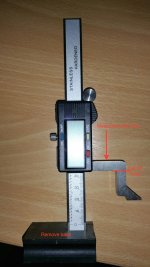cliffp
Member
- Joined
- Jun 22, 2012
- Messages
- 517
I have not yet found the perfect solution to measuring or marking wood where I want the distance to be along an axis that is accurately orthogonal to an edge (I know this is what all of us want to do routinely!).
At the moment, I use my Woodpecker 600m square to get the 90 degrees, line a 1 meter ruler against it, use an engineers square to align the end of the ruler against the edge of the wood and mark with a good marking knife (using reading glasses). Apart from the palaver, it is difficult to judge fractions of a mm. I like the idea of a T Square (such as Woodpecker's) but this would not (I imagine) easily permit measurements/marking sub mm.
It occurred to me that if you could make a T square in which the measurement limb (the long part) did not have a detailed scale but instead had detents so that a moveable carriage could be precisely slid along it and engaged with it (a bit like the LR32 plate the router is mounted to) at different locations. These locations could be 100mm (metric) or 4" (imperial). For a DIY'er, the increments could be 32mm using the LR32 system. This carriage would have to be made such that it fitted precisely so that its axis was always aligned with the T square arm.
If components from a digital height gauge such as the one shown below (with indicated parts removed) were attached to the carriage and this assembly mounted to the T square long limb at precisely defined points, the gauge would enable accurate and easily accomplished measurements/marks within that range (typically 100 or 150mm). If we arranged our detents such that it was possible to zero the height gauge when the measurement edge (as indicated with an arrow in the photo) was aligned with the edge of the wood and the other detents were at 100mm, 4" or 32mm (depending on our chosen measurement system) intervals, we could add this offset to the gauge reading for the overall measurement. The gauge head could be locked down so that if we chose to set a distance we wanted to transfer onto several workpieces we could.
[attachimg=1]
At the moment, I use my Woodpecker 600m square to get the 90 degrees, line a 1 meter ruler against it, use an engineers square to align the end of the ruler against the edge of the wood and mark with a good marking knife (using reading glasses). Apart from the palaver, it is difficult to judge fractions of a mm. I like the idea of a T Square (such as Woodpecker's) but this would not (I imagine) easily permit measurements/marking sub mm.
It occurred to me that if you could make a T square in which the measurement limb (the long part) did not have a detailed scale but instead had detents so that a moveable carriage could be precisely slid along it and engaged with it (a bit like the LR32 plate the router is mounted to) at different locations. These locations could be 100mm (metric) or 4" (imperial). For a DIY'er, the increments could be 32mm using the LR32 system. This carriage would have to be made such that it fitted precisely so that its axis was always aligned with the T square arm.
If components from a digital height gauge such as the one shown below (with indicated parts removed) were attached to the carriage and this assembly mounted to the T square long limb at precisely defined points, the gauge would enable accurate and easily accomplished measurements/marks within that range (typically 100 or 150mm). If we arranged our detents such that it was possible to zero the height gauge when the measurement edge (as indicated with an arrow in the photo) was aligned with the edge of the wood and the other detents were at 100mm, 4" or 32mm (depending on our chosen measurement system) intervals, we could add this offset to the gauge reading for the overall measurement. The gauge head could be locked down so that if we chose to set a distance we wanted to transfer onto several workpieces we could.
[attachimg=1]

